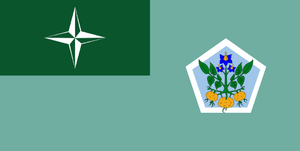Avenirskara: Difference between revisions
mNo edit summary Tag: 2017 source edit |
mNo edit summary |
||
| Line 4: | Line 4: | ||
| colspan=2 | <hr> | | colspan=2 | <hr> | ||
|- | |- | ||
| style="font-size: 10.2pt; background: #fcfcfc; text-align: center;" colspan=2 | ''' | | style="font-size: 10.2pt; background: #fcfcfc; text-align: center;" colspan=2 | '''Axerka Avenirskara'''<br>'''Colony of Avenirskara''' | ||
|- | |- | ||
| align=center colspan=2 style="padding: 0em 0em 0.5em 0em; text-align: center; background: #fcfcfc;"| [[File: | | align=center colspan=2 style="padding: 0em 0em 0.5em 0em; text-align: center; background: #fcfcfc;"| [[File:AvenirskaraFlag.png|300px]]<br><small>Flag</small> | ||
|- | |- | ||
| align=center colspan=2 style="padding: 0em 0em 0.5em 0em; text-align: center; background: #fcfcfc;"| | | align=center colspan=2 style="padding: 0em 0em 0.5em 0em; text-align: center; background: #fcfcfc;"| | ||
| Line 30: | Line 30: | ||
| '''Official languages''' || [[Kiravic Coscivian|Kiravic]] | | '''Official languages''' || [[Kiravic Coscivian|Kiravic]] | ||
|- | |- | ||
| '''Other Languages''' || Maīoki | | '''Other Languages''' || Maīoki Cronite | ||
|- | |- | ||
| '''Postal Abbreviation''' || | | '''Postal Abbreviation''' || ASK | ||
|- | |- | ||
| colspan="2" bgcolor="#3CB371" | | | colspan="2" bgcolor="#3CB371" | | ||
| Line 40: | Line 40: | ||
[[Category:Kiravian federal subjects]] | [[Category:Kiravian federal subjects]] | ||
''' | '''Avenirskara''' is a Kiravian colonial territory located in northern [[Cusinaut]]. It has a southern temperate climate. | ||
==History== | ==History== | ||
Avenirskara was the second Kiravian colony to be established on the mainland of Cusinaut, being administratively separated from the territory of the first, [[Porfíria]]. The first Kiravian settlement was built early in [YEAR] at Parera by a group of 700 colonists contracted by the Colonial Authority. | |||
[The rest of the lore is out of date and no longer computes] | |||
==Politics== | ==Politics== | ||
Avenirskara has a chartered colonial government with the four familiar executive, fiscal-legislative, resolutive-judicial, and fiduciary-conservative branches found in many mainland Kiravian state governments. | |||
[[File:Schloßkirche am Schloßteich..jpg|thumb|Vómrasar]] | [[File:Schloßkirche am Schloßteich..jpg|thumb|Vómrasar]] | ||
==Society and Culture== | ==Society and Culture== | ||
Back-to-the-land movement. More displacement and reservation, less miscegnation makes for a more purely Coscivian culture. Variety of ethnic groups, rooted multiethnic communities, usually united by religious denomination. | Back-to-the-land movement. More displacement and reservation, less miscegnation makes for a more purely Coscivian culture. Variety of ethnic groups, some rooted multiethnic communities, usually united by religious denomination. | ||
Exurban development in the eastern corner of the colony. | |||
[[Category:KRV]] | [[Category:KRV]] | ||
Revision as of 23:38, 6 September 2021
| Axerka Avenirskara Colony of Avenirskara | |
 Flag | |
| Country | Kiravian Federacy |
| Capital | Vómrasar |
| Largest City | Parera |
| Population | 1,866,000 |
| Governor | Alisdair Stornovén |
| President | Darius Torsigram |
| Stanora seats | 2 |
| Official languages | Kiravic |
| Other Languages | Maīoki Cronite |
| Postal Abbreviation | ASK |
Avenirskara is a Kiravian colonial territory located in northern Cusinaut. It has a southern temperate climate.
History
Avenirskara was the second Kiravian colony to be established on the mainland of Cusinaut, being administratively separated from the territory of the first, Porfíria. The first Kiravian settlement was built early in [YEAR] at Parera by a group of 700 colonists contracted by the Colonial Authority.
[The rest of the lore is out of date and no longer computes]
Politics
Avenirskara has a chartered colonial government with the four familiar executive, fiscal-legislative, resolutive-judicial, and fiduciary-conservative branches found in many mainland Kiravian state governments.

Society and Culture
Back-to-the-land movement. More displacement and reservation, less miscegnation makes for a more purely Coscivian culture. Variety of ethnic groups, some rooted multiethnic communities, usually united by religious denomination.
Exurban development in the eastern corner of the colony.